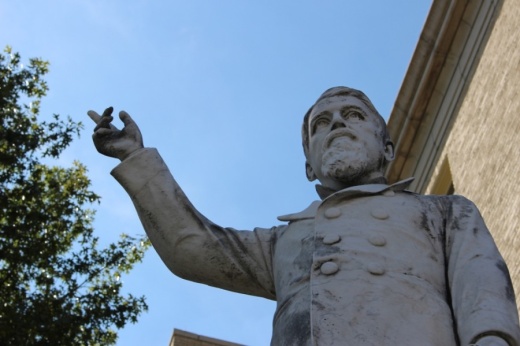Following months of research, a petition with over 1,900 signatures, three advisory board meetings and two City Council meeting discussions, McKinney’s City Council voted for a second time to postpone any decision concerning the Throckmorton statue.
The Feb. 2 vote pushes the decision until at least May.
James W. Throckmorton was a controversial yet notable person in North Texas history for his roles as a Confederate Army captain, one-year governor of Texas and slave owner. According to Guy Giersch, the city’s long-time historic preservation officer who is retiring, Throckmorton’s contributions helped pave the way for McKinney’s current economic prosperity.
The Throckmorton statue is located downtown in front of the McKinney Performing Arts Center, which served as the Collin County courthouse until 1979. Last summer, the city began researching the historical context, appropriateness and relevance of the statue in McKinney’s downtown after a number of residents asked for the statue's removal.
The ad hoc advisory board—comprised of community members, not city staff—was put together to oversee the research. The board met three times in August and September to discuss the research and what the statue might symbolize for different McKinney residents.
A survey was sent out to the community to receive feedback on what should be done with the statue. Options included leaving the statue in place, adding additional signage, adding additional statues of other important figures, removing and placing it in storage, removing and installing somewhere else, and removing and selling the statue—potentially to a museum.
The public input survey, which was conducted from Sept. 10-27, garnered 2,094 total responses. Of this, 1,781 respondents said they resided in a McKinney ZIP code.
The majority of McKinney residents who responded to the survey were in favor of leaving the statue in place, city staff said. Similarly, the majority of nonresidents who responded to the survey were also in favor of leaving the statue in place.
But some community members and leaders are fervently opposed to keeping it, arguing that it is a “physical reminder every day” of a time when Black residents of McKinney were not equal to their white counterparts.
Chris Thornton, who was appointed to McKinney City Council in December but was unable to serve because his residence is 10 feet outside the city’s District 1, said the statue has its finger pointing toward the east side of McKinney, which has historically been lower income and populated by more Black and Latino residents than the other side of Highway 5.
“I'm reminded of all ... the racial epithets that [were] hurled at us as children ... [in] the movie theater, reminding us that once [the movie] was over, we need to return back to where we belong,” Thornton said.
“And so I think it's time now, it's time for it [the statue] to go.”
The council did not reach a decision concerning the statue at its October meeting. Nor did council members reach consensus on how to move forward at their Feb. 2 meeting.
Four council members—Frederick Frazier, Rainey Rogers, Rick Franklin and Charlie Philips—voted to postpone a decision on how to proceed. The other three council members, Angela Richardson-Woods, Scott Elliott and Mayor George Fuller, voted against tabling the decision.
“How many more meetings do we have to have?” asked Richardson-Woods. “I don't know how much more information we need to have to make a decision. So, I don't agree with kicking it down the road.”
Frazier said it’s been difficult, after listening to both sides, to reach a decision.
“If we take a few more months, or however long we take to get to the end of that road, that's not going to make a big difference,” Frazier said. “But we can get to the end of the road together. And that's the thing that's going to make the difference.”





